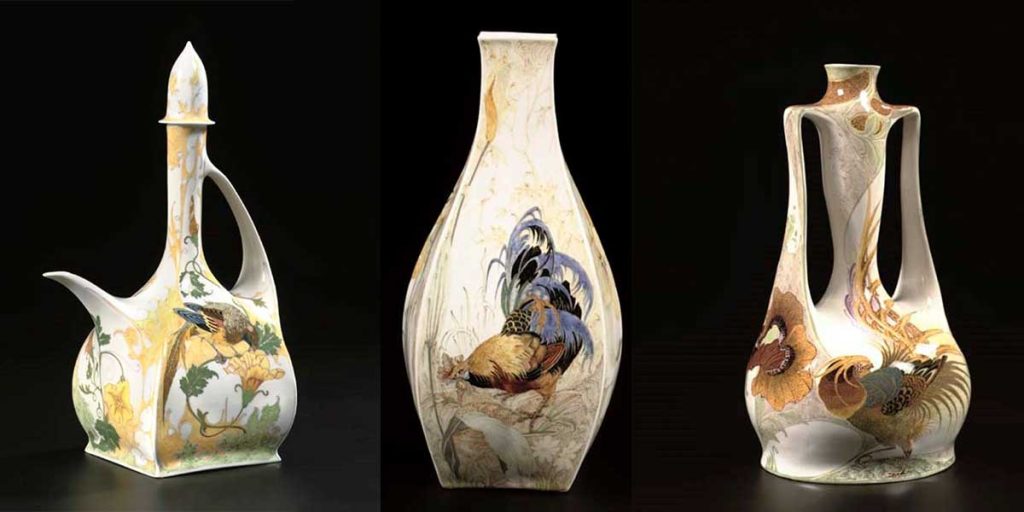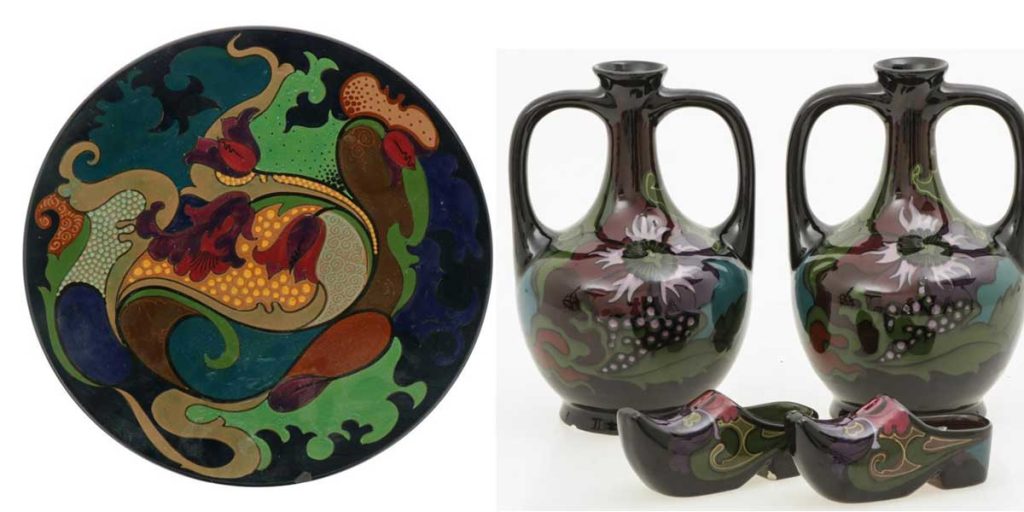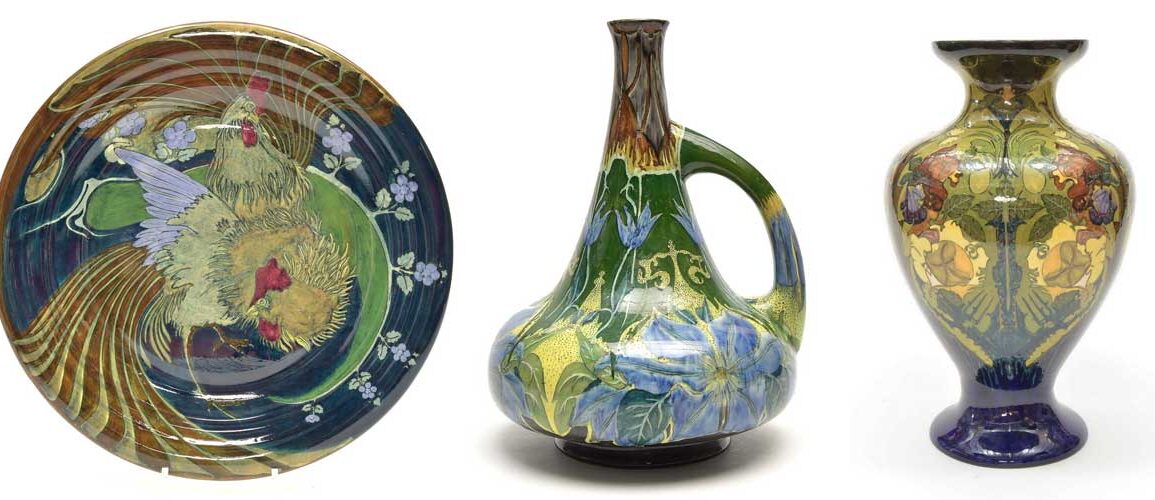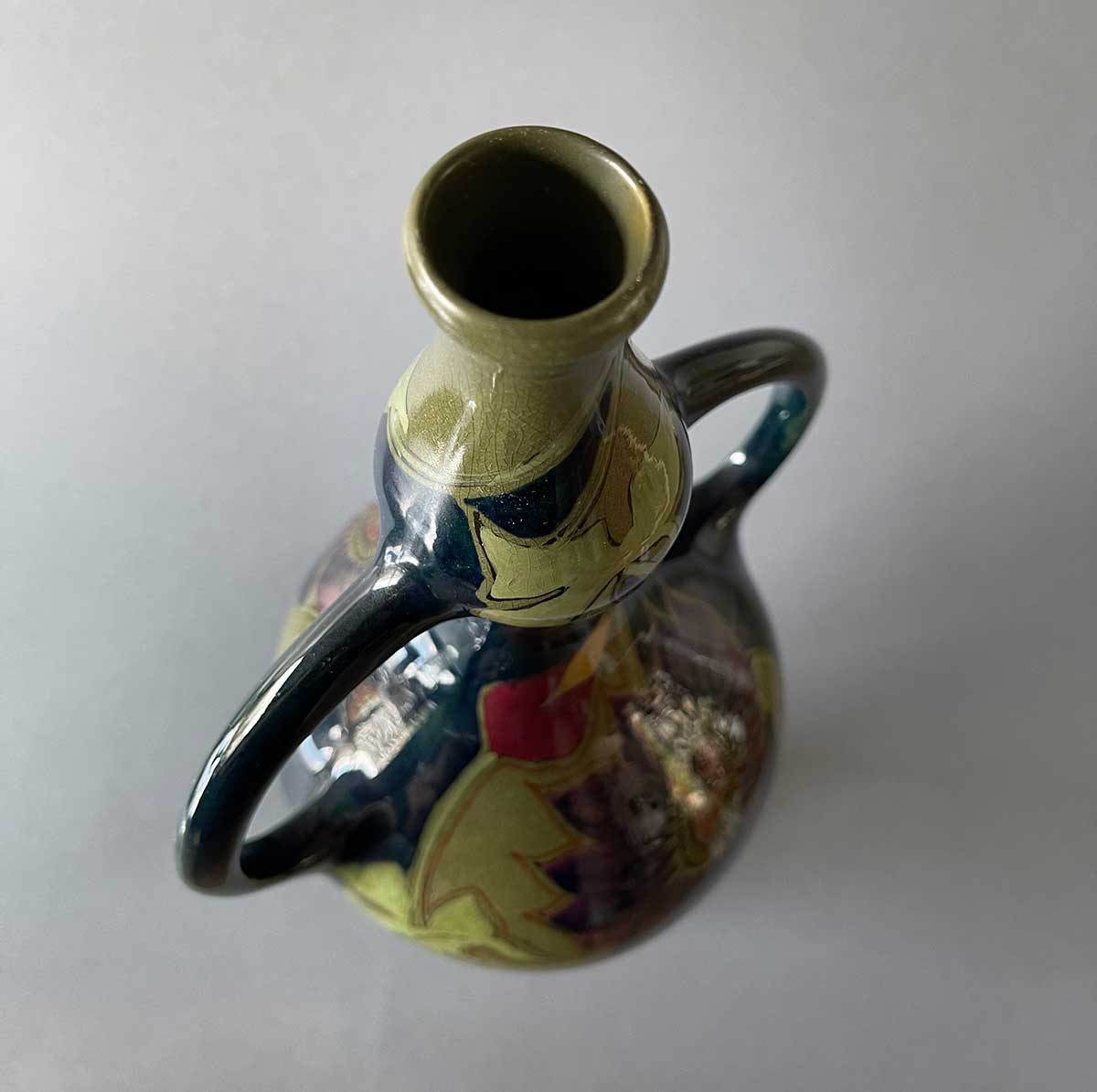What is Dutch Gouda and Rozenburg Pottery Worth?
Do you own an antique Dutch Pottery vase or wall charger? Dutch Art Nouveau Pottery, or ‘plateel’ is collected all over the world. If you are curious about the value of your vase then, read on. Also if you would like advice on how to best sell your Gouda or Rozenburg pottery.
Hand painted and glazed decorative pottery of Dutch origin is very popular amongst collectors. Dutch Gouda and Rozenburg Pottery is made of porous earthenware, formed in moulds, hand-painted in different colours and decors and provided with a layer of matt or glossy glaze. Dutch Pottery is also called plateel, faience or majolica.
How do you determine the value of Dutch antique pottery?
Dutch antique pottery from the Art Nouveau Period come in all shapes and sizes. You could say that pottery costs anywhere between €10 and €10,000. Determining the value depends on various factors, such as damage, age, size, the depicted decors, the designer and the artist who painted the pottery. There are 7 important factors that determine the value of Gouda or Rozenburg pottery.
1: Damage
Antique Pottery is fragile and sometimes very old. If a vase, bowl, wall charger or ewer is damaged, its value drops considerably. Sometimes up to half the price, compared to objects in good condition. If the damage is very subtle, such as a piece of glaze that is missing, a hairline crack, or a very small chip of a neck or a foot (in short: damage that is not clearly visible or easy to restore), then the loss of value is less.
2: The Age of an Object
Dutch pottery has been made for a very long time and is still made by artisans today. As a rule, the older the pottery, the higher the price. Most Dutch pottery items have marks on the bottom. There, you see the name of the factory, the name of the painter and often also a year sign. On the basis of these signs you can see how old the pottery is. Dutch Antique Pottery from the nineteenth century and early twentieth century (between 1800 and 1910) is worth more than pottery from later time periode (from 1910-1965). Many Dutch pottery factories, such as Zuid-Holland Gouda, Rozenburg Den Haag, Brantjes Purmerend and Holland Utrecht, started their production in the late nineteenth century. In the early years of the existence of these factories, production was low. Few vases, bowls, wall chargers and ewers were made. Around 1900, Dutch pottery became very popular. This is due to the fact that several Dutch pottery factories took part in world wide exhibitions and started international trade. Many factories increased production. The production process also changed and innovations were launched.
3: Famous Dutch Pottery Factories
It is important to know where Dutch pottery is made. A lot of pottery comes from Gouda, for example from Plateelbakkerij Zuid-Holland. This factory existed for a long time (from 1898 to 1965) and they produced lot of pottery. Goedewaage from Gouda also existed for a long time, from 1922 to 1982. Finally, there is the Regina pottery factory, which produced pottery between 1898 and 1979. Due to the long production period, Gouda pottery is much less rare than pottery from other cities.
Dutch Pottery from the Rozenburg Factory (1883 – 1914) is expensive, because the factory only existed for a short time. Rozenburg pottery is rare, has a very good international reputation and is therefore very popular on the market. Rozenburg produced both earthenware and eggshell porcelain.especially this super delicate eggshell porcelain is very sought after and prices have remained high throughout the years. Other Dutch Pottery factories from the Art Nouveau or Jugenstil period, such as Firma Weduwe Brantjes from Purmerend (1895-1904), pottery from Holland/Mijnlieff from Utrecht (1896-1913) and pottery from De Distel from Amsterdam (1895-1922), are collected all over the world, and prices are generally high then Gouda Pottery.
4: Famous artists and painters of Dutch Pottery
You could say that pottery makers fall into two categories: painters and artists. The artists were the ones who designed the shape of the objects, just like the decors on pottery, and sometimes even painted them by hand. Their vases are often unique and therefore very rare. Well-known names are Theodoor Colenbrander, Henri Breetveld, Samuel Schellink, Chris van der Hoef, W.P. Hartgring, J.H. Hartgring, J.W. van Rossum, J.W. van Schaick, Leendert Muller or Jan Schonk.
A great deal of pottery has been painted on pottery by painters using templates. As a result, the craftsmanship is a lot less and, and moreover, there are many comparable objects on the market. The more look-a-like objects there are on the market, the lower the price.
5: The Size of Ceramic Objects
In short: the larger an object, the more it is worth.
6: Decors on Dutch Pottery
You could argue that dragons, fish, birds and insects on the pottery are worth more than flowers or abstract motifs (with the exception of the work of Theodoor Colenbrander). Most Dutch Art Nouveau Pottery will depict flowers. Some are unique and hand-painted by artist (see 4). They are worth more than decors that are made in great numbers. This also applies to the difference in matt and glossy glazed ceramics. High glazed ceramics were made between 1885 and 1925. Matt glazed was an invention from the Gouda factory Zuid-Holland from 1908 and was produces well in the the 1960’s. Because of the longer production period and therefor a great abundance, prices of matt glazed Pottery are lower.
7: Developments in the market
The value of Dutch Antique pottery goes up and down and prices at auctions change over time. You can say that Dutch Art Nouveau Pottery was worth much more about 20 to 25 years ago than it is now. That is a question of supply and demand. The more people collect pottery, the more objects are wanted and the more prices rise. Developments in the market are also erratic. If many people bid on the same vase at an auction, the price will rise. If only a few people are interested, you can sometimes buy pottery below market value. My experience shows that very similar objects are sold for very different prices at (online) auctions.
Dutch Art Nouveau Pottery of the highest Value
Eggshell porcelain, made by the Rozenburg Pottery Factory from The Hague in the Netherlands has the highest value in the market. Eggshell porcelain was made between 1900 and 1914 by Rozenburg Den Haag. The value of this porcelain is between €1,000 and €15.000, depending on the factors described above. Below I have compared five different objects. Three of these were sold in 2006 via Christies, two in 2021 via Veilinghuis Botterweg in Amsterdam. You can see that prices for eggshell porcelain have fallen considerably in a number of years. You can also state that prices in the Netherlands are a little lower, compared to prices abroad. And different auctioneers ask different prices, depending on the audiences they serve and the reputations they hold.


Dutch pottery with a high value
Dutch pottery from the Art Nouveau Period, 1885-1915, is very popular. Decorative pottery from famous Dutch Pottery factories such as Rozenburg, Brantjes, Holland Utrecht and Distel Amsterdam are often painted in dark colours, with typical Art Nouveau style elements. Also pottery from the early days of Plateelbakkerij Zuid-Holland in Gouda has a high value on the market today. Pieces range from €300 to €3,000. In the early days of production, the pottery was often painted freehand by well-known artists and designers. These pieces are therefore unique.


Dutch Antique Pottery with a lower value
The Art Nouveau Period was slowly turning out of fashion in Western-Europe around the year 1910. Nevertheless, most of the Gouda pottery factories manufactured pottery with graceful lines and floral decors, which are so characteristic of the Art Nouveau Style, well into the 1930’s. The following applies to the value determination: the younger a piece of earthenware, the lower its value. Art Nouveau pottery from the 1920s and 1930s has a lower value than Art Nouveau pottery from the period around and just after the turn of the century (1895-1910). You should think of prices from € 100 to € 300.

How to sell you Dutch Gouda en Rozenburg Pottery
At Action Houses
Dutch Antique Art Nouveau Pottery is sold all over the world to collectors and enthusiasts. Especially in the Netherlands, where the pottery originally comes from, pottery can often be seen at auctions. Most auction houses in the Netherlands regularly hold antique auctions where pottery forms part of the offer. You can sell your antique items at an auction. Then you must submit photos and a description of your objects. At most auction houses you can offer antiques by e-mail and then an employee of the auction house will advise what the value of the pottery is and whether it is interesting enough to sell. If pottery ends up at the auction, you can sometimes agree to a minimum or starting price, but you have no controle over the actual outcome. As the owner, you will be paid after the end of the auction, minus the auction house’s commission (between 20 and 30% of the sales price). Several auction houses can be found in most major cities.
Online auctioneers
If you don’t want to sell your Dutch Pottery at a traditional auction (and spare the high auctioneer’s fees), you can sell items via online auctions, such as Catawiki, Ebay or Marktplaats. Here the commissions on sales are lower or absent altogether. You must first register with these online platforms before you offer your pottery for sale. Catawiki works more like an auction. First an expert assesses the object and then it is offered for a limited time (usually 12 days). Whoever has left the highest bid after the time expires, buys the object. You have no controle over the price, your item will sell for. So prices can be high or lower than your expectations. The money will be transferred to the original owner after the auction, minus a 9% commission. At Ebay or Marktplaats you can give your object a longer period to find a buyer and candidates can make an offer. Here you have more controle over the outcome of the sale.
Sell pottery via ArtNouveauPlateel.nl
This site specialises in selling pottery made in the Netherlands between 1885 and 1915 (sometimes even 1920). We are always looking for new pieces for the collection. Do you have pottery from this period? And do you want to sell it? Then we are happy to help. We sell pottery in consignment. This means that you remain the owner of your object, whilst the object is in our store and consignment happens only after we have agreed on the best sales price and the sales periode. Read more about the possibilities on the page: sales of pottery in consignment.


